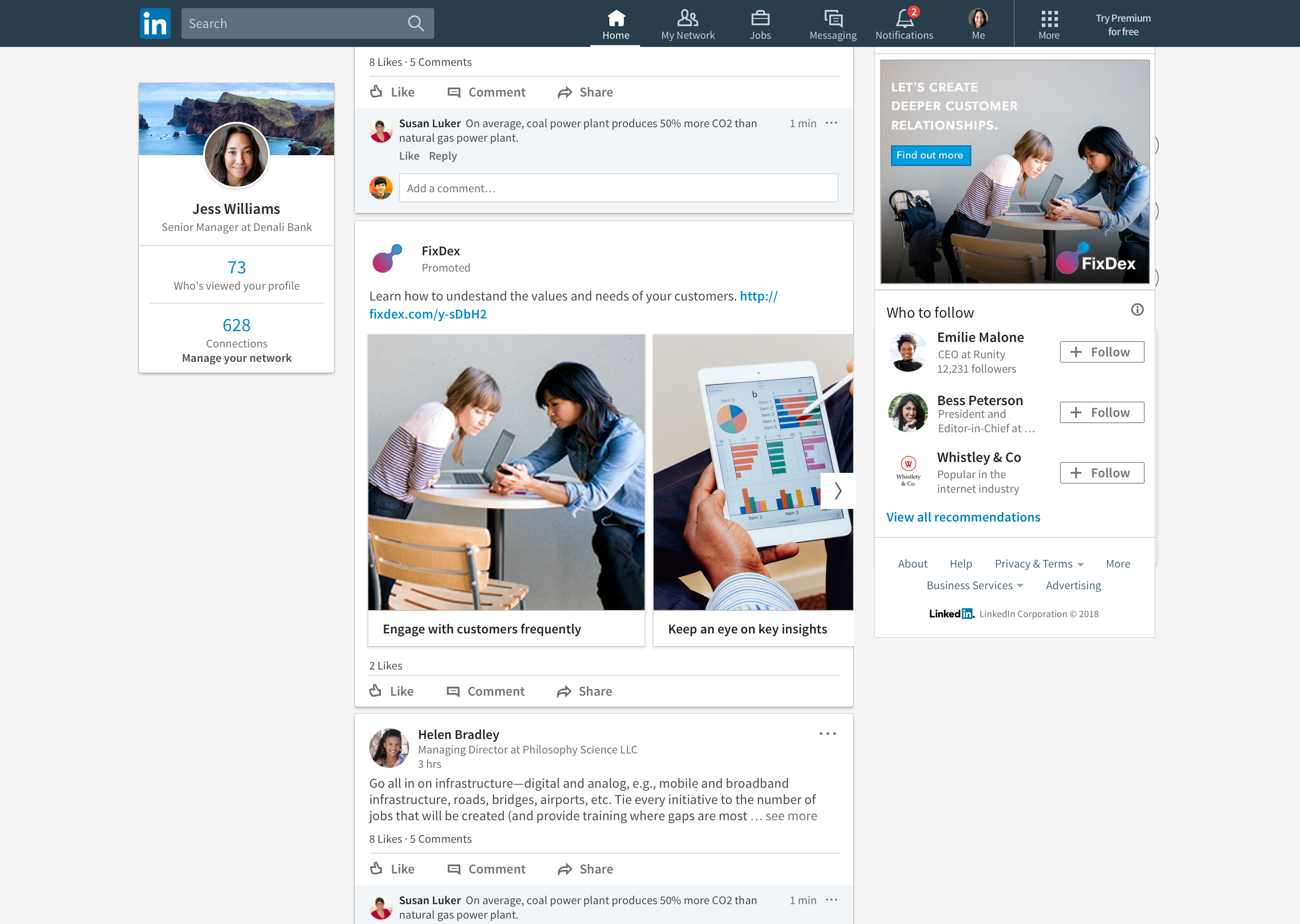6 costly social media mistakes B2B companies make
B2B companies who do not invest in social media marketing are putting themselves at a major disadvantage in 2020.
That being said, investing in the wrong type of social strategy will inevitably lead to wasted time and money, which could be better allocated elsewhere.
With numerous ways to strategize your social media efforts, B2B companies with a longer sales cycle may struggle to decipher the best way to interact with their audience.
Nevertheless, remember you can always reach B2B stakeholders via social media, ensuring the correct strategies are used to do so.
Deciding on the best platforms to optimise tactics is crucial, and allows B2B marketers to increase brand awareness, nurture relationships with target customers and showcase company products and services to the right audience.
Here are some of the most common social media fails made by B2B companies, and a guide on how you can safeguard your company against them:
-
Lack of investment in advertising
Do you regularly publish content on social media but fail to garner engagement from your followers? One of the greatest social media mistakes B2B companies make is ignoring investment in content promotion and advertising. The reality is that without sponsored posts on your various social media channels, your content won’t reach your existing customers and the new prospects you want to target. Each social media site offers marketers various advertising options which enable them to broaden their reach.
For example, LinkedIn, the king of B2B social media offers marketers two types of advertising on its site. They include sponsored updates and text ads which both allow you to drive traffic to your website. The difference between the two formats are the way in which they are displayed on a user’s LinkedIn newsfeed.
- Sponsored Updates: (highlighted in red below)
People who view a sponsored update are given multiple options. They can either access your website by clicking on the link or the image on the ad, click through to your company profile, or follow your page directly.
- Text Ads: (highlighted in blue below)
Viewers of text ads can only click through to your website via the link or image in your ad.

LinkedIn Ad examples
Note: It’s important to closely monitor your LinkedIn ad analytics especially due to their higher cost tendency in comparison to other social channels.
-
Separating your social media from SEO
Overlooking the integration of social media and SEO is a common mistake made by the majority of businesses with many B2B companies still failing to recognise the correlation between an optimised social media presence, and the positive impact it can have on organic website traffic. Active social media accounts increase the likelihood of your profile ranking naturally on Google, particularly when people search for your company name.
When prospects are at the research stage in their buyer’s journey, they will check your social media pages to access further information and gauge what type of company you are. Make sure you are easily found when prospects begin their online search by taking a proactive approach to social media activities.
Read: SEO 101: An explanation for beginners
-
Trying to focus on every social media channel
While having a strong, focused social media presence is crucial, irrespective of industry or business size, it’s important to recognise that it’s impossible to appeal to and cater for everyone.
Especially if your budget is limited, it’s a good idea to choose the social channel that offers the greatest returns and predominantly focus your efforts there.
It’s not a matter of randomly selecting Facebook, Twitter or LinkedIn, you must distinguish which channel your target audience spend their time on to allocate the greatest portion of your resources.
Tip: If you’re still unsure where to begin, LinkedIn is a good starting point for B2B companies, generating more leads than all the other social channels combined.
-
Lacking a repeatable content strategy
Every social media channel is focused around content.
Many B2B companies struggle to continuously keep their followers engaged with a never-ending content strategy. On Twitter for example, content has an extremely short life span of around 20 minutes while on Facebook and LinkedIn, content lives for a few hours max.
It’s challenging for companies to steadily create and share fresh pieces of content daily.
B2B companies can combat these issues by generating a repeatable content strategy that repurposes content, saving your marketing dept. time and effort.
Here’s how to create a repeatable content strategy:
- Internal company experts: Rather than solely relying on your marketing team to generate content ideas, why not encourage employees in other parts of the business to provide industry perspectives around their subject area.
- Share content from or about your business: Be it a blog post, a press release, magazine publication or a product video, showcase content you have created yourself and external parties have published about your company.
- Re-share content: Switch up the format of existing content, for example transforming a blog post into an infographic, or combine numerous blogs into a whitepaper or eBook. You can also repurpose evergreen blog posts by simply updating stats, images and the overall structure. Create various headline copy for each blog and share and test them repeatedly across each of your social media profiles to distinguish what works best.
- Always use images or video: We can’t stress the importance of imagery and video enough. People love them, and on social media, you will be competing with a multitude of photos, videos and infographics. Take time to create a post that stands out and makes an impression on your target audience. If under budget constrictions, there are multiple websites online where you can avail of free stock images. For those of you lucky enough to have an in-house design team, why not ask them to create stand out images or animated gifs to use across your social channels.
-
Posting without a strategy
When using Twitter and Facebook, don’t just retweet and share other people’s content.
Not only is it a lazy approach to social media, it also doesn’t showcase your opinion or provide any insight into your company. While it’s important to retweet and share, do it sparingly and with plenty of your own input in between.
When voicing your expertise, do so in a way that really interests and educates your target audience, in particular, consider ways you can address their pain points.
Social media is all about communication and should form a two-way conversation with your audience. Don’t come across as ‘salesy’ by constantly posting about your company’s products and services.
Instead, offer your opinion on industry issues, research and trends and provide information that will assist your target audience.
Finally, don’t try to be everything to everyone.
There’s a balance between broader engagement and message dilution. You need to find out what topics your audience want to see and formulate your social media strategy around this research.
By remaining focused, you will keep your audience interested and essentially get the results you want.
-
Avoiding new formats of content
One of the greatest social media fails B2B companies make is sticking with the same, mundane forms of content.
Why not spice up your social presence by trying out video, infographics or eye catching presentations?
Video has evolved as a popular method for marketers to showcase their products and services, appealing to social users much more than an ordinary status update.
Here are some new content formats your B2B company should try:
- Engaging videos: With 87% of online marketers using video content1, it’s one of the most interactive and successful forms of content. Try creating a video showcasing what your business is about, incorporating your product and service offering. Another good idea is a ‘Questions and Answers’ video, webinar or a product/service review.
- Direct social media publishing: On top of sharing your website blog content on your profile, consider publishing new content directly on social platforms. LinkedIn and SlideShare are prime native content channels to try out. Remember to make every piece of content varied on each medium by switching up the copy and imagery.
- Social media influencers: One of the greatest ways to spur social awareness of your B2B company is to build relationships with industry experts and influencers. Catching the eye of influencers can lead to potential mentions for your company, be it shares of your own content or even content written about you. This kind of publicity is a positive step towards increasing your brand awareness online.
If there’s one key point you take away from this post, it’s to always keep your social media accounts active!
One of the most prolific mistakes made by B2B companies is simply neglecting social media with the impression that it shouldn’t be a priority.
With the fluidity of social media, there are so many opportunities to try and test out new social strategies to distinguish what works best for your company.
Whether you sell automated equipment or technical software, with the right approach and creativity, social media can enhance your online presence and overall business success.
Sources:
1 HubSpot
